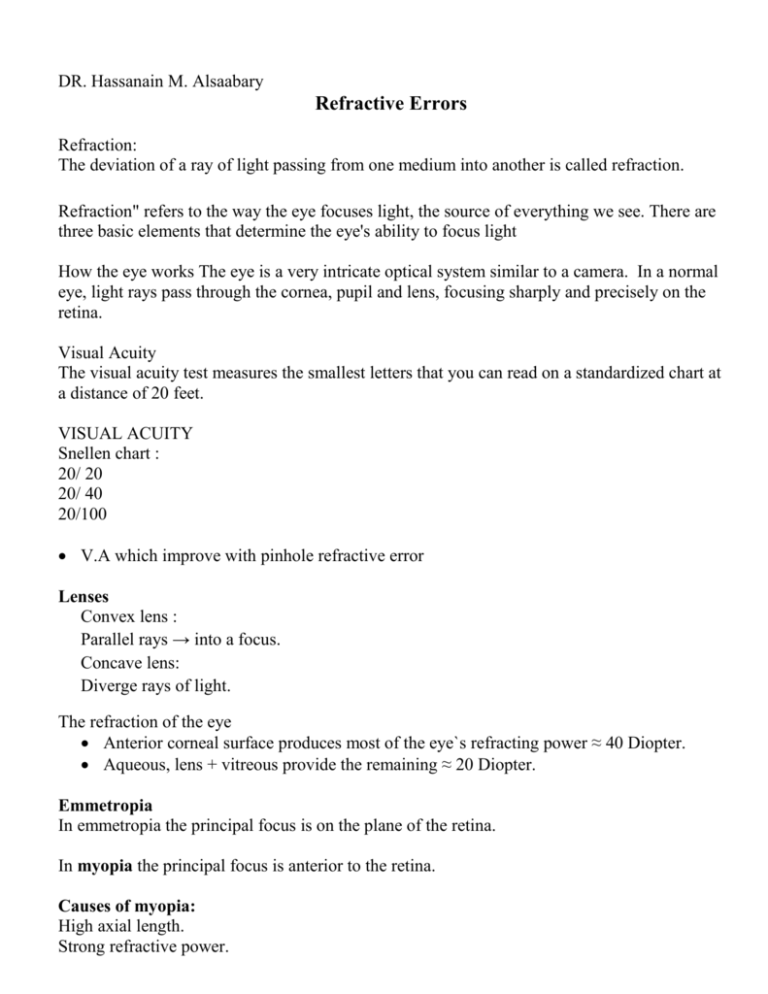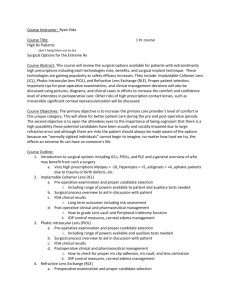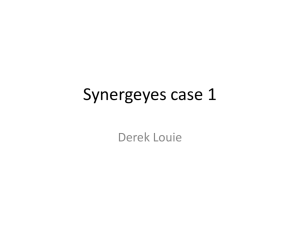refractive error lecture
advertisement

DR. Hassanain M. Alsaabary Refractive Errors Refraction: The deviation of a ray of light passing from one medium into another is called refraction. Refraction" refers to the way the eye focuses light, the source of everything we see. There are three basic elements that determine the eye's ability to focus light How the eye works The eye is a very intricate optical system similar to a camera. In a normal eye, light rays pass through the cornea, pupil and lens, focusing sharply and precisely on the retina. Visual Acuity The visual acuity test measures the smallest letters that you can read on a standardized chart at a distance of 20 feet. VISUAL ACUITY Snellen chart : 20/ 20 20/ 40 20/100 V.A which improve with pinhole refractive error Lenses Convex lens : Parallel rays → into a focus. Concave lens: Diverge rays of light. The refraction of the eye Anterior corneal surface produces most of the eye`s refracting power ≈ 40 Diopter. Aqueous, lens + vitreous provide the remaining ≈ 20 Diopter. Emmetropia In emmetropia the principal focus is on the plane of the retina. In myopia the principal focus is anterior to the retina. Causes of myopia: High axial length. Strong refractive power. Clinical features patients usually have problem in seeing at distance. The vision at near is normal. 4 myopic will see clear at ¼. 25 C.M 6 myope? V.A. improves with pinhole. Myopes squeeze their eyes to see clearly. In hypermetropia the principal focus is behind the retina, and is therefore virtual. Causes of hypermetropia: Decreased Axial length Weak refractive power . Aphakia After cataract surgery , lens is removed and we have to substitute it with : Intra ocular lens. Contact lens. Glasses. ASTIGMATISM Regular: The directions of greatest and least curvature are always 90 degree apart. Corrected by a cylindrical spectacle lens. Irregular:The principal meridians are not perpendicular to one another. Example: Corneal scar due to trauma or keratoconus. Corrected by hard lens. THE DEVELOPMENTAL EVOLUTION OF THE REF. STATE Low grade hyperopia is the usual ref. State in infancy and childhood. As the child grows;changes in axial length,cornea,and lens compensate for each other toward emmetropia. ANISOMETROPIA Difference in the refractive errors of the two eyes. Uncorrected anisometropia in children may lead to amblyopia. Unilateral aphakia.(one eye without lens) Anisometropia : achild 3-y-old, OD: +3 OS:+1 Amblyopia OD. ACCOMMODATION The accommodation is the ability to focus the eye when viewing objects at close distances. When an attempt is made to look at a near object, the lens within the eye changes shape (accommodates). This shape change occurs as a result of impulses sent to muscles inside of the eye. As objects get closer during viewing, impulses are also sent to the external muscles of the eye to converge or turn the eyes inward in order to avoid seeing a double image. This convergence system allows us to keep single vision of objects when viewing from distance to near. These two systems of Accomodation and Convergence work together and provide input into one another to maintain one clear image when viewing objects close up. Presbyopia its reduction of amplitude of accomodation with age(after 40),due to sclerotic changes in lens fiber and capsule and reduction of efficacy of ciliary body Example A 20 year old c / o decrease vision for distance. V.A: 20 / 80 ; PH 20 / 30 Ref. Error. Auto.ref. -3 Auto.ref. –3 –2 x 180. Astigmatism Pt who had difficulty in reading. V/A 20 / 100 PH 20/40. Auto.ref: +4. Convex glasses. 15 y old boy ;VA 20/100 PH 20/40 ;at 33cm 20/20 MYOPIA REF.ERR -3 A 50 –y- old man started to have difficulty in reading. VA 20 /20 PRESBYOPIA. CONTACT LENSES SOFT: spherical ref error . HARD:keratoconus. TORIC:spherocylidrical ref error. RISK OF CONTACT LENSES? 12345- How we correct myopia Photorefractive keratectomy(PRK) Laser in situ keratomileusis (LASIK) Clear lens extraction gives very good visual results but carries a small risk of retinal detachment. Iris clip (‘lobster claw’) implant is attached to the iris . Complications include subluxation, an oval pupil, endothelial cell loss, cataract, pupillary-block glaucoma and retinal detachment. Phakic posterior chamber implant (implantable contact lens, ICL) is inserted behind the iris and in front of the lens , and supported in the ciliary sulcus. The lens is composed of material derived from collagen (Collamer) with a power of −3 D to −20.50 D. Visual results are promising but the procedure may be associated with uveitis, pupillary-block glaucoma, endothelial cell loss, cataract formation and retinal detachment How we correct hypermetropia (hyperopia) 1- PRK can correct low degrees of hypermetropia. 2- LASIK can correct up to 4 D. 3- Conductive keratoplasty (CK) involves the application of radiofrequency energy to the corneal stroma and can correct low to moderate hypermetropia and hypermetropic astigmatism. Burns are placed in one or two rings in the corneal periphery using a probe. The resultant thermally-induced stromal shrinkage is accompanied by an increase in central corneal curvature. 4- Laser thermal keratoplasty with a holmium laser can correct low hypermetropia. Laser burns are placed in one or two rings in the corneal mid-periphery . As with CK, thermallyinduced stromal shrinkage is accompanied by increased corneal curvature. This change decays over time but treatment can be repeated. 5- Other modalities include intracorneal inlays, and clear lens extraction and phakic lens implants as described above for myopia. ASTIGMATISM TREATMENT 1- Limbal relaxing incisions/arcuate keratotomy involves making paired arcuate incisions on opposite sides of the cornea in the axis of the correcting ‘plus’ cylinder (the steep meridian). 2- PRK can correct up to 3 D. 3- LASIK can correct up to 5 D. 4- Lens surgery involves using a ‘toric’ intraocular implant incorporating an astigmatic correction. 5- Conductive keratoplasty Refractive surgery alters the curvature of the cornea to allow light rays to come to focus closer to the retina, thus improving uncorrected vision. In myopia, the central corneal curvature is flattened; in hyperopia, the central corneal curvature is made steeper; and in astigmatism, the cornea is made more spherical. Photorefractive keratectomy (PRK) is used for persons with low to moderate myopia. The excimer laser is used to flatten the central corneal tissue through photoablation. The excimer laser uses an argon fluoride gas mixture to create ultraviolet energy that is able to break intermolecular bonds with submicron precision. Each pulse of the laser removes 0.25 µ of corneal tissue. The corneal epithelium is removed before photoablation and generally takes 3 days to regenerate. During the procedure, laser delivery to the cornea usually lasts < 1 min. PRK can safely treat higher degrees of myopia than can radial keratotomy, with > 90% of people seeing 20/40 or better without glasses. In laser in situ keratomileusis (LASIK), a flap of corneal tissue is created with a microkeratome, is turned back, and then the stromal bed is sculpted with the excimer laser. In the great majority of cases, the flap adheres tightly to the stromal bed without the need for sutures. Because the surface epithelium is not disrupted centrally, visual recovery is rapid. Most people notice a significant improvement in their vision 1 day postoperatively. LASIK can be used to treat myopia, astigmatism, and hyperopia.








